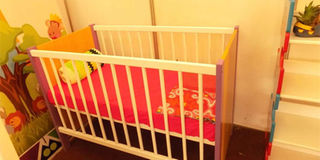Furnishing kids’ rooms

When furnishing the nursery, Ms Kibe advises, you should buy the crib first since it is the focal point and you might wish to match other pieces of furniture with it. PHOTO | FILE | NATION MEDIA GROUP
What you need to know:
- Ms Selina Kibe asserts that safety should be the primary concern when selecting furniture for your children.
- She advises against buying second-hand mattresses for children as they might harbour germs and vermin such as bedbugs.
- A good option is to get a crib that converts into a toddler bed or a full bed so that your child can use it longer.
As you’re shopping around for furniture for your child’s room, you might just find out that buying furniture for a child takes a lot more than you imagine. This is because you have to consider factors such as durability, comfort, price and safety, when buying furniture that is appropriate and safe for your child.
Ms Selina Kibe, a home economics lecturer who has taught in several technical training institutions around the country, asserts that safety should be the primary concern when selecting furniture for your children.
“Children are intrinsically adventurous and will always want to tag, climb or run into furniture. You will be surprised by how many children get injured, and even die, as a result of using unsafe furniture either at home or school,” says Ms Kibe.
Perhaps the first thing you should be aware of, Ms Kibe says, is that furniture in a child’s room should ideally have only rounded edges. If you have furniture that has sharp edges, it is advisable to install caps on them. These caps, which can be bought from local hardware stores, reduce the possible impact of the furniture should your child run into it.
And while second-hand furniture might come cheap (or free in the case of donations from friends and family), it can pose risks to your child if you do not inspect it thoroughly.
“Make sure that second-hand furniture is still solid and stable. Look out for rough surfaces, rust or corrosion and any parts that stick out, like nails,” she suggests.
BUY THE CRIB FIRST
She advises against buying second-hand mattresses for children as they might harbour germs and vermin such as bedbugs.
When furnishing the nursery, Ms Kibe advises, you should buy the crib first since it is the focal point and you might wish to match other pieces of furniture with it. Pay close attention to the bars on the crib, which she says should be no more than five centimetres apart. If the spaces between them are too wide, a child could easily fall out of the crib, or even get stuck between the bars. It is also important to ensure that the crib does not have any horizontal board that the baby can use to climb out.
“When the child is in its crib, avoid filling it with toys and pillows, as these might suffocate or even strangle him or her. The crib should contain only a firm mattress and a sheet,” she says.
When a child outgrows the crib, many parents tend to go for a bunk bed because it optimises space, especially if siblings have to share a room.
“Many Kenyans are using the metallic bunk beds used in many boarding schools. Such beds are unsafe because they lack proper guard rails that can prevent a child from falling should they roll over too far,” Ms Kibe notes.
NO SPACE BETWEEN BED AND WALL
She adds that when placing a bunk bed against the wall, you should ensure there is no space between the bed frame and the wall.
“Children under the age of six should never be allowed to sleep on the top bunk,” she says.
When buying a baby dresser, Ms Kibe advises that you choose a changing table that can also function as a drawer so that you won’t have to dispose of it when the baby grows older. Besides, you can also convert such a changing table into a bookshelf later on.
A good option is to get a crib that converts into a toddler bed or a full bed so that your child can use it longer. By thinking long-term, you’ll save yourself money and the trouble of buying new furniture later.=
Children play a lot with their furniture, which accelerates wear and tear, so go for furniture that durable and sturdy, even though such furniture might be costly.
Ms Kibe notes that as a child goes through the teething process, he or she tends to gnaw at the edges of tables, chairs and other furniture. Because of this, you should ensure whatever furniture you buy does not have lead-based paint because it is toxic. This is particularly important if you buy second-hand furniture and repaint it.
When buying a study table for your child, it is important that the table have space for a computer keyboard and filing cabinets.
“Today’s kids grow up around computers because unlike us, they are learning to do their homework and school projects on computers,” Ms Kibe notes.
When furnishing a room for a child above three years of age, it is advisable to ask for their opinion when selecting a colour theme for their room or buying furniture. Take them shopping with you because they will appreciate and the furniture and handle it with more care if they’re involved in acquiring it.
Further, Ms Kibe advises that you anchor your furniture to the wall as far as possible to avoid accidents in case your child inadvertently pushes or runs into it.
“Keep your child’s stuff low and within their reach to discourage him or her from climbing on top of furniture to retrieve them,” she says.




